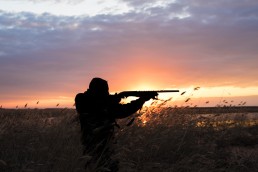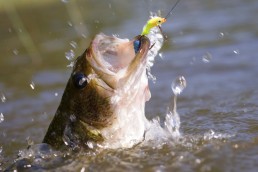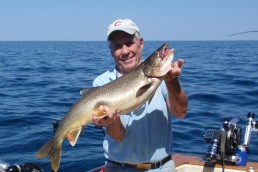Indiana News
SHARE THIS POST
Indiana lake whitefish record broken twice in two weeks
The state record for lake whitefish has been broken twice in just two weeks by anglers in Lake Michigan.
Josh Pisowicz was targeting whitefish on February 19 on the Michigan City pier and caught a 5-pound, 9-ounce specimen. Pisowicz submitted a record-fish application to DNR officials, and the next day they certified his fish, which beat the previous record set in 2015 by Dan Rostecki by 1 ounce.
On February 28, Alexander Ciesielski submitted a record-fish application for a 5-pound, 13-ounce whitefish he caught near Portage Lakefront Park on January 21. Ciesielski was not targeting whitefish, but knew as soon as he landed it he had a record contender. DNR officials certified Ciesielski’s record back on March 3.
Ciesielski’s fish marks the fifth record-lake whitefish since the state established a category for the species in 2012.
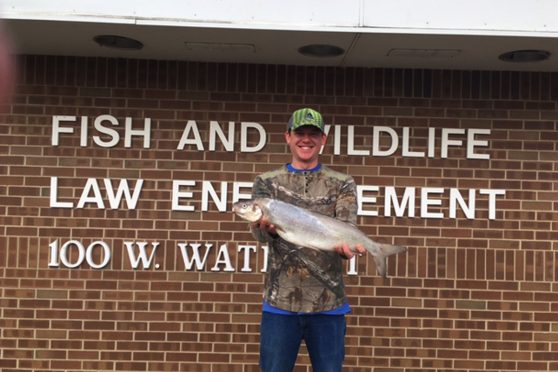
Assistant Lake Michigan fisheries biologist Ben Dickinson thinks the Ciesielski record may not last long either.
“We consistently see whitefish over 6 pounds in our netting assessments, and last year we had several weighing over 7 pounds,” Dickinson said. “There are probably hundreds of fish swimming around Indiana waters right now that would break the record.”
Whitefish have been targets of commercial fishing operations in northern Lake Michigan for years due to demand for their flaky, white flesh. Recently, sport anglers have started targeting them in southern Lake Michigan.
Whitefish are a great resource for Hoosiers because they are abundant, delicious, and accessible to shore anglers, according to Brian Breidert, a DNR Lake Michigan fisheries biologist.
“They can be caught using simple techniques, such as bottom fishing with a 1- to 2-ounce weight, a 12- to 24-inch leader and a small hook baited with waxworms, salmon eggs or bits of nightcrawler,” Breidert said.
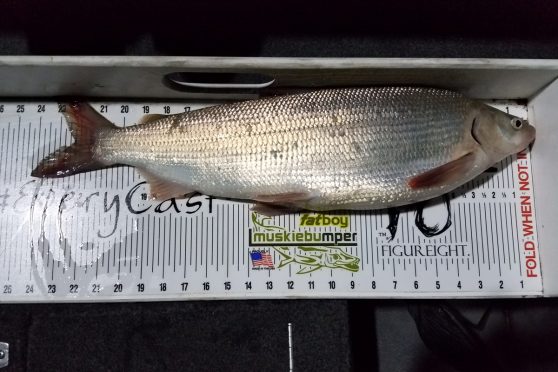
Whitefish are caught from most of Indiana’s shore access on Lake Michigan, especially the piers at Portage Lakefront Park and Michigan City and the Port of Indiana shore-fishing site.
Typically, the best fishing occurs between November and April, when nearshore water temperatures are below 50 degrees. Whitefish spawn near the shore in late fall and stay during winter and early spring to feed on crustaceans, small fish, invertebrates and mussels.
Bass rules at Kunkel Lake
Anglers headed to Kunkel Lake in Ouabache State Park near Bluffton must follow a largemouth bass rule concerning fish size and the daily bag limit this spring. For Kunkel Lake, the minimum size limit for keeping a largemouth is 18 inches, and no more than two bass may be taken daily. The rule went into effect in 2015 after a bass and bluegill restocking project in 2013.
Now, any bass less than 18 inches long must be returned unharmed to the lake.
By protecting big bass, biologists hope to maintain good bass fishing and keep the bluegill reproduction in check. In the past, bluegills overran the 25-acre impoundment. Their large population resulted in slow growth and most bluegills were just too small to interest the anglers. Biologists say ensuring a dense bass population should also help keep carp and other unwanted fish from overtaking the lake.
Assistant DNR fisheries biologist Tyler Delauder is concerned some anglers may not be aware of the bass limit or may be tempted to keep undersized bass while fishing bluegills.
“These bass are our insurance policy on the lake and are needed to keep the lake in balance,” Delauder said.
Bluegill fishing should be good this spring, according to Delauder. Many are already in the 7-plus-inch range. Few if any bass, however, will be large enough to keep. Most caught last summer were around 10 to 12 inches long.
“It will be several more years before they reach the 18-inch size limit,” Delauder said.
Muskie egg supply concerns
A decline in the number of adult muskies at Lake Webster in Kosciusko County has DNR biologists worried about a potential shortage of eggs to use in the state’s muskie stocking program.
Traditionally, Lake Webster is where biologists have caught adult females to harvest eggs for Fawn River State Fish Hatchery in Orland.
“We need 15 to 20 ripe female muskies each spring to get enough eggs for hatching,” said Tom Meyer, assistant manager at Fawn River. “From these eggs, we are able to produce about 15,000 muskie fingerlings to stock 13 waters throughout the state.”
Last spring at Lake Webster, the DNR caught only 11 females “ripe” with eggs. To supplement the egg supply, biologists set traps in nearby James Lake where six more female muskies were caught and provided the additional eggs.
“If necessary, the DNR will return to James Lake again this year,” Meyer said.
What caused the muskie decline at Lake Webster?
Meyer isn’t sure, but says steps have been taken to rebuild the population and they seem to be working as anglers are reporting catching more young muskies.
“We increased the amount of time that muskie fingerlings are fed minnows before stocking,” Meyer said. “We also started a study to see if stocking muskies in the spring, when more natural food is available, can increase their survival.”
To deal with the potential shortage of muskie eggs, hatcheries may be able adjust operations to prevent a drop in the number of fingerlings available to stock.
Lake Webster provided some of the best muskie fishing in the Midwest just a decade ago.
“We’d like to restore its reputation,” Meyer says. “Our stocking program and muskie fishermen depend on it.”
Indiana lake trout limit increase
Indiana is changing the daily bag limit for lake trout in Lake Michigan. On April 1, the limit increased from two fish per day to three per day under an emergency rule while waiting for a permanent rule to be approved. Indiana biologists used input from multiple user groups in crafting the regulation.
The increase puts Indiana in sync with Michigan’s bag limit. Since many Indiana boaters routinely fish in both states during the same trip, having the same bag limit for both states will make fishing less complicated.
Additionally, the increased bag limit offers more harvest opportunities for lake trout in the spring and fall when they are readily available in Indiana waters as the nearshore fishery for trout becomes even more popular.
Biologists are confident the lake trout population can sustain the additional harvest pressure. The lake trout population has been increasing in the southern basin due to the changing Lake Michigan ecosystem.
Harden Lake fish habitat
Fish and anglers both will benefit from a DNR habitat project at Cecil M. Harden (Raccoon) Lake. DNR fisheries biologists and partner organizations hope to develop more than 350 fish habitat features in the lake by the end of 2018. The project includes rock piles, brush piles, wooden structures and clusters of vertical posts.
The improvements at Raccoon Lake are the second such project by a year-old initiative of the DNR Division of Fish & Wildlife called the Reservoir Aquatic Habitat Enhancement Program. The program builds fish habitat in reservoirs lacking natural structure, and will be the first such project involving Sullivan Lake.
“We are building on what we learned at Sullivan Lake and including more partners in our latest project,” said Sandy Clark-Kolaks, DNR southern fisheries research biologist.
Raccoon Lake is a 2,060-acre U.S. Army Corps of Engineers (USACE) flood-control impoundment near Rockville. Each winter, the USACE draws down water levels by 22 feet, which impedes aquatic vegetation growth. Aquatic vegetation is a key factor in fish habitat.
Partners in the project include the USACE, Bass Unlimited and the Indiana Bass Federation.
This winter, the DNR placed three rock pile complexes at locations near the Raccoon Lake ramp and marina. A rock pile complex consists of large rock placed in 1-ton piles. There will be 20 piles placed in a 1-acre space.
A volunteer day will take place at the lake this fall. Volunteers will be able to help DNR biologists build more than 100 wooden habitat structures to place in the lake over winter.
Are you enjoying this post?
You can be among the first to get the latest info on where to go, what to use and how to use it!
Indiana Fish of the Year
Twenty-five anglers were honored in 2016, including Jeff Armstrong of Wheatfield, who submitted five winning catches. Close to half of the 2016 winners were the only entry for that specific species, so don’t hold back if you catch a nice fish in 2017.
Listed below are the 2016 Fish of the Year winners, the size of the fish and where the fish was caught:
Blue catfish: 50 inches, Shawn M. Harris, Ohio River (Ohio County)
Bluegill: 11 inches, Jeff Armstrong, Lake Maxinkuckee (Marshall), and Dennis Thompson, Krueger Lake (Jefferson)
Bowfin: 32 1/2 inches, Mark Holbrook, Tippecanoe River (Pulaski)
Buffalo: 38.3 inches, Brian Waldman, Cagles Mill Lake (Owen, Putnam)
Bullhead: 16 inches, Paul Weber, private pond (Lake County)
Channel catfish: 42 inches, Nicholas R. Staigl, Lake McCoy (Decatur)
Cisco: 15.3 inches, Robert Ecenbarger, Little Crooked Lake, (Whitley)
Common carp: 32 1/2 inches, Jeff Armstrong, Bass Lake (Starke)
Crappie: 18.3 inches, Mike Pasini, private lake (Johnson)
Flathead catfish: 50 inches, Jason Metz, Eel River (Clay)
Freshwater drum: 26 1/2 inches, Sheena Donald, Ohio River (Switzerland)
Green sunfish: 11 inches, Luke Tincher, private pond (Orange)
Hybrid striped bass: 30 inches, Hao Wu, Tippecanoe River (Carroll)
Largemouth bass: 29 inches, Greg Burchett, private lake (Ripley)
Longnose gar: 43.3 inches, Tristan Mobley, Wabash River (Gibson)
Northern pike: 42 1/2 inches, Robert L. Kelley, Marsh Lake (Steuben)
Rainbow trout: 20 inches, Larry A. Sheets, Olin Lake (LaGrange)
Redear sunfish: 12 inches, William Endorf, Midland Lake (Greene)
Rock bass: 11.8 inches, Jeff Armstrong, Lake Maxinkuckee (Marshall)
Sauger: 23 1/2 inches, Jeff Armstrong, Tippecanoe River (Marshall)
Shortnose gar: 28.3 inches, Johnathon Marshall, Wabash River (Parke)
Smallmouth bass: 20 1/2 inches, Steven O. Williams, Tippecanoe River (White)
Spotted gar: 24.3 inches, Mark Losee, Simonton Lake (Elkhart)
Steelhead: 38.1 inches, Tristan Weaver, Trail Creek (LaPorte)
Striped bass: 40.3 inches, Kody Neece, Hardy Lake (Scott)
Sucker: 25 inches, Joseph Bickel, Wabash River (Huntington)
Walleye: 27 1/2 inches, Mark Holbrook, Tippecanoe River (Pulaski)
Warmouth: 9 1/2 inches, Mark Losee, Simonton Lake (Elkhart)
White bass: 19 1/2 inches, Jeff Armstrong, Lake Maxinkuckee (Marshall)
White catfish: 28 inches, Shawn M. Harris, Bischoff Reservoir (Ripley)
Yellow bass: 11 inches, Kody Neece, Hardy Lake (Scott)
Yellow perch: 14 1/2 inches, Sullivan Hubert, Lake of the Woods (Marshall)
Within the coming months of this year, if you think you’ve caught a possible winner, be sure to measure the length of the fish, have at least one person who is not a relative witness the measurement, take one or more photos of the fish, preferably a photo of you holding it and to remember to visit wildlife.IN.gov/3577.htm for an entry form and complete it, including the witnesses name and contact information and a copy of your fishing license (if required), and then send it to Record Fish Program, Division of Fish & Wildlife, 402 W. Washington St., Room W273, Indianapolis, IN, 46204 or submit by email to recordfish@dnr.IN.gov.
Treestand takedown
Indiana Conservation Officers, in coordination with Brookville Complex personnel, located and removed 21 treestands from Brookville Complex State Property in Union and Franklin counties on March 27. In an effort to protect our natural resources and serve our community, the officers teamed up with Brookville Complex personnel to remove several treestands failing to adhere to property regulations.
Indiana Administrative Code 312 IAC 9-3-3 (g) describes an individual “must not erect, place, or hunt from a permanent tree or ground blind on state-owned lands.” Any tree or ground blind placed on DNR property must be portable and may be left overnight only between noon on September 15 and January 10 (see page 24 of the 2016/2017 Hunting and Trapping Regulation booklet). Indiana Administrative Code further indicates any fastener used in conjunction with a tree blind and a tree or pole climber penetrating a tree more than 1/2 an inch is prohibited.
Each blind placed on DNR property must be legibly marked with the name, address and telephone number of the owner of the blind or marked with the individual’s customer identification number issued by the DNR.
Equipment and fasteners left on or within a tree causes unnatural growth, which can lead to the death of the tree.
The treestands removed were scattered throughout the Brookville Complex property in Union and Franklin County. All the treestands seized were not removed by their owners by January 10. The majority of the stands removed were not marked with owner identification. All treestands located were seized and documented with location information for owner identification. The stands will be stored for a period of 90 days to allow the owner to claim their property.
MWO
SHARE THIS POST
You may also like...
Did you enjoy this post?
You can be among the first to get the latest info on where to go, what to use and how to use it!
Jack Spaulding
Jack Spaulding is an outdoor columnist living in his hometown of Moscow, Ind. with his wife, Chris. From childhood, the smallmouth bass-infested Big Flat Rock River and the surrounding hardwood forest has been his playground. He has written Spaulding Outdoors for MidWest Outdoors since 1986. Email to jackspaulding@hughes.net.
